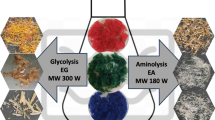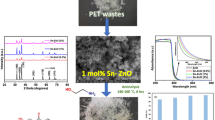Abstract
This work is aimed at electrochemical decolorization of real waste liquid which obtained in the PET depolymerization process. Firstly, PET fabrics were glycolysized by utilizing excess ethylene glycol (EG). Then, the glycolysis product was mixed with water and purified through repeated crystallization to get bis(2-hydroxyethyl) terephthalate (BHET) crystal. At last, the waste liquid of the depolymerization process was electrochemical decolorized by utilizing chitosan/Fe3O4 nanoparticles as the dispersed electrodes under a DC voltage. The UV-Vis absorptions at 338, 531, and 635 nm which were due to the dyes in the waste liquid decreased with the electrolysis time. In contrast, slight change of absorption of EG (at 322 nm) indicated that EG was not destroyed in the electrolytic process. The variation of color removal efficiency with dosage of chitosan/Fe3O4 nanoparticles, applied voltage, concentration of electrolyte, pH and electrolytic time were investigated. The max color removal efficiency was 87.24%. PET fabrics were depolymerized by using the decolorized waste liquid or mixture of decolorized waste liquid and EG (1:1 v/v), and the yields of BHET were 72.3% and 76.6%, respectively. The products were BHET without dyes which were confirmed by DSC and FTIR spectroscopy.

Graphical abstract







Similar content being viewed by others
References
Abdelaal MY, Sobahi TR, Makki MSI (2011) Chemical transformation of pet waste through glycolysis. Constr Build Mater 25:3267–3271
Awaja F, Pavel D (2005) Recycling of pet. Eur Polym J 41:1453–1477
Bartolome L, Imran M, Cho BG, Al-Masry WA, Kim DH (2012) Recent developments in the chemical recycling of PET. In: Achilias DS (ed) Material recycling-trends and perspectives. Intech, Rijeka, pp 65–84
Dullius J, Ruecker C, Oliveira V, Ligabue R, Einloft S (2006) Chemical recycling of post-consumer pet: alkyd resins synthesis. Prog Org Coat 57:123–127
Eldesoky HS, Ghoneim MM, Zidan NM (2010) Decolorization and degradation of Ponceau S azo-dye in aqueous solutions by the electrochemical advanced Fenton oxidation. Desalination 264:143–150
George N, Kurian T (2014) Recent developments in the chemical recycling of postconsumer poly(ethylene terephthalate) waste. Ind Eng Chem Res 53:14185–14198
Ghaemy M, Mossaddegh K (2005) Depolymerisation of poly(ethylene terephthalate) fibre wastes using ethylene glycol. Polym Degrad Stab 90:570–576
Haber F, Weiss J (1934) The catalytic decomposition of hydrogen peroxide by iron salts. Proc R Soc Lond 147:332–351
Hassan H, Hameed BH (2011) Fe-clay as effective heterogeneous Fenton catalyst for the decolorization of Reactive Blue 4. Chem Eng J 171:912–918
He Z, Chao G, Qian M, Shi Y, Chen J, Shuang S (2014) Electro-Fenton process catalyzed by Fe3O4 magnetic nanoparticles for degradation of C.I. Reactive Blue 19 in aqueous solution: operating conditions, influence, and mechanism. Ind Eng Chem Res 53:3435–3447
Iyer SD, Joshi PV, Klein MT (2010) Automated model building and modeling of alcohol oxidation in high temperature water. Environ Prog Sustain Energy 17(4):221–233
Li GY, Jiang YR, Huang KL, Ding P, Chen J (2008) Preparation and properties of magnetic Fe3O4 –chitosan nanoparticles. J Alloys Compd 466:451–456
Li M, Huang Y, Ju A, Yu T, Ge M (2014a) Synthesis and characterization of azo dyestuff based on bis(2-hydroxyethyl) terephthalate derived from depolymerized waste poly(ethylene terephthalate) fibers. Chin Chem Lett 25:1550–1554
Li M, Huang Y, Yu T, Chen S, Ju A, Ge M (2014b) Chemical recycling of waste poly(ethylene terephthalate) fibers into azo disperse dyestuffs. RSC Adv 4:46476–46480
Li M, Luo J, Huang Y, Li X, Yu T, Ge M (2014c) Recycling of waste poly(ethylene terephthalate) into flame-retardant rigid polyurethane foams. J Appl Polym Sci 131:5829–5836
Lin YH, Leu JY (2008) Kinetics of reactive azo-dye decolorization by pseudomonas luteola in a biological activated carbon process. Biochem Eng J 39:457–467
López-Fonseca R, Duque-Ingunza I, Rivas BD, Arnaiz S, Gutiérrez-Ortiz JI (2010) Chemical recycling of post-consumer pet wastes by glycolysis in the presence of metal salts. Polym Degrad Stab 95:1022–1028
Luo X, Li Y (2014) Synthesis and characterization of polyols and polyurethane foams from pet waste and crude glycerol. J Polym Environ 22:318–328
Luo M, Yuan S, Man T, Peng L, Xie W, Xu X (2014) An integrated catalyst of Pd supported on magnetic Fe3O4, nanoparticles: simultaneous production of H2O2, and Fe2+, for efficient electro-Fenton degradation of organic contaminants. Water Res 48:190–199
Mahmoodi NM, Najafi F, Khorramfar S, Amini F, Arami M (2011) Synthesis, characterization and dye removal ability of high capacity polymeric adsorbent: polyaminoimide homopolymer. J Hazard Mater 198:87–94
Moral A, Irusta R, Martín JM, Martínez L (2007) Depolimerization of pet bottle wastes to produce high-value BHET monomer using ethylenglycol. Chem Eng Trans 11:479–484
Namasivayam C, Kavitha D (2002) Removal of Congo Red from water by adsorption onto activated carbon prepared from coir pith, an agricultural solid waste. Dyes Pigments 54:47–58
Pardal F, Tersac G (2006) Comparative reactivity of glycols in pet glycolysis. Polym Degrad Stab 91:2567–2578
Radha KV, Sridevi V, Kalaivani K, Raj M (2009) Electrochemical decolorization of the dye acid orange 10. Desalin Water Treat 7:6–11
Rusevova K, Kopinke FD, Georgi A (2012) Nano-sized magnetic iron oxides as catalysts for heterogeneous Fenton-like reactions-influence of Fe(II)/Fe(III) ratio on catalytic performance. J Hazard Mater 241-242(1):433–440
Shukla SR, Harad AM, Jawale LS (2008) Recycling of waste pet into useful textile auxiliaries. Waste Manag 28:51–56
Sohrabnezhad S, Pourahmad A (2010) Comparison absorption of new methylene blue dye in zeolite and nanocrystal zeolite. Desalination 256:84–89
Wang CT, Chou WL, Chung MH, Kuo YM (2010) COD removal from real dyeing wastewater by electro-Fenton technology using an activated carbon fiber cathode. Desalination 253:129–134
Wasti A, Awan MA (2016) Adsorption of textile dye onto modified immobilized activated alumina. J Assoc Arab Univ Basic Appl Sci 20:26–31
Welle F (2011) Twenty years of pet bottle to bottle recycling—an overview. Resour Conserv Recycl 55:865–875
Yue QF, Wang CX, Zhang LN, Ni Y, Jin YX (2011) Glycolysis of poly(ethylene terephthalate) (pet) using basic ionic liquids as catalysts. Polym Degrad Stab 96:399–403
Funding
This work was financially supported by the National High-tech R&D Program of China (No. 2016YFB0302901), the Fundamental Research Funds for the Central Universities (No. JUSRP51723B), the China Scholarship Council (No. 201706795025), the Open Project Program of Fujian Key Laboratory of Novel Functional Fibers and Materials (Minjiang University) (No. FKLTFM1713), and the National Natural Science Foundation of China (No. 31501566).
Author information
Authors and Affiliations
Corresponding author
Additional information
Responsible editor: Bingcai Pan
Highlights
• This work aimed at electrochemical decolorization of real waste liquid which is obtained in the PET depolymerization process.
• The PET depolymerization waste liquid included ethylene glycol, water, and dyes that were electrolyzed in a three-dimensional electrode reactor under DC voltage.
• The chitosan/Fe3O4 dispersed electrodes facilitated the electrolytic efficiency and could be collected by magnet after reaction.
• The decolorized PET depolymerization waste liquid could be reused for glycolysis of PET without color interference.
Rights and permissions
About this article
Cite this article
Li, M., Li, Y., Lu, J. et al. Decolorization and reusing of PET depolymerization waste liquid by electrochemical method with magnetic nanoelectrodes. Environ Sci Pollut Res 25, 34531–34539 (2018). https://doi.org/10.1007/s11356-018-3377-0
Received:
Accepted:
Published:
Issue Date:
DOI: https://doi.org/10.1007/s11356-018-3377-0




